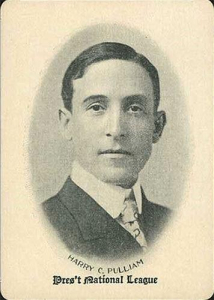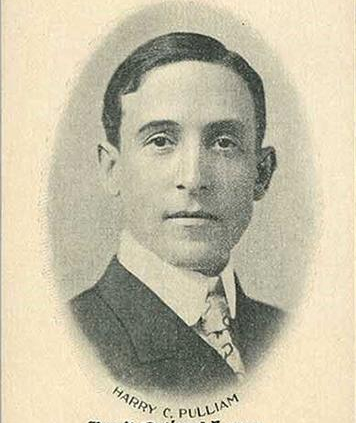Harry Pulliam
 Described as “an idealist, a dreamer, and a lover of solitude and nature,” Harry Pulliam was an eccentric dresser (one reporter wrote that “all the colors of the rainbow were utilized by him in the color scheme of his fancy waistcoats”) and fabled storyteller who put all around him at ease, rising to high places in each of his chosen professions through hard work and a charming demeanor. Pulliam became a successful baseball executive with the Louisville and Pittsburgh National League franchises, and as NL President he was an innovative administrator who helped stabilize major-league baseball at a critical juncture in its history. He was publicly lauded throughout his career for integrity and square dealing, but self-doubt and a nervous nature were at the core of his existence, and at age 40 he took his own life. Certainly his temperament was ill suited for his position, yet Harry Pulliam left a lasting mark on baseball by helping to clean the game of rowdy play and bring peace between the two leagues.
Described as “an idealist, a dreamer, and a lover of solitude and nature,” Harry Pulliam was an eccentric dresser (one reporter wrote that “all the colors of the rainbow were utilized by him in the color scheme of his fancy waistcoats”) and fabled storyteller who put all around him at ease, rising to high places in each of his chosen professions through hard work and a charming demeanor. Pulliam became a successful baseball executive with the Louisville and Pittsburgh National League franchises, and as NL President he was an innovative administrator who helped stabilize major-league baseball at a critical juncture in its history. He was publicly lauded throughout his career for integrity and square dealing, but self-doubt and a nervous nature were at the core of his existence, and at age 40 he took his own life. Certainly his temperament was ill suited for his position, yet Harry Pulliam left a lasting mark on baseball by helping to clean the game of rowdy play and bring peace between the two leagues.
The son of a tobacco farmer, Harry Clay Pulliam was born on February 9, 1869, in Scottsburg, Kentucky. After attending public schools in Louisville, Harry graduated from the University of Virginia School of Law before entering journalism, starting as a cub reporter at the Louisville Commercial and rising through the ranks to become city editor. In that position he made the acquaintance of a local entrepreneur named Barney Dreyfuss—some credit him with teaching his German friend proper English—and soon was in Dreyfuss’ employ, first as secretary and later president of the National League’s Louisville Colonels. During his time in the newspaper business Harry had become interested in politics; while with the Colonels he served in the Kentucky Assembly as a Democrat representing Louisville’s sixth and seventh wards. Dubbed the “Red Bird Statesman” for successfully introducing a bill to protect that species, Pulliam was known as a capable legislator.
Harry Pulliam’s role in a pair of turn-of-the-century incidents helped shape baseball history. While serving as president of the Colonels, he was pestered relentlessly by a minor-league outfielder and Louisville native named Claud McFalrane about a stocky, bow-legged infielder playing minor-league ball in Paterson, New Jersey. Though he resisted for some time, Pulliam finally went to see young Honus Wagner while the Colonels were playing in Brooklyn. With Dreyfuss’ backing, the Colonels secured Wagner’s services for $2,100 and Pulliam himself accompanied the raw, young talent on the train from New Jersey to the Bluegrass State. Undoubtedly Harry’s gentle nature played a role in making Wagner feel comfortable about leaving the Northeast, and it’s telling that he allowed Wagner to stop in his hometown of Carnegie on the way to Louisville.
It was that same gentlemanly demeanor that helped the Pittsburgh Pirates, run after 1900 by Dreyfuss and Pulliam after their consolidation with the Louisville organization, to retain the core of talent that became a National League dynasty. When Ban Johnson, later a Pulliam ally, announced that his upstart American League would be considered a second major league, and would attain talent by disregarding the NL’s reserve clause, Dreyfuss and Pulliam visited or wired each Pirate player to assure his loyalty. Though it’s commonly held that Pittsburgh lost no players to the AL raid because Johnson masterminded a plot to leave the Pirates intact, there’s evidence that at least one AL manager, Clark Griffith, and perhaps as many as two others visited Pittsburgh to try to lure Wagner away. Pulliam’s congeniality and proactive nature helped stave off raids.
NL magnates tabbed the 33-year-old Pulliam as the loop’s president, secretary, and treasurer on December 12, 1902, replacing the clumsy three-man executive board, which just a year earlier had deposed the ineffective Nick Young. Dreyfuss reportedly wept at the news that his primary lieutenant was leaving him. Harry was by all accounts a capable and decisive administrator, but he soon came cross-wise with New York Giants owner Andrew Freedman. Pulliam’s first re-election was unanimous, and his next two were by 7-1 votes, but Cincinnati’s Garry Herrmann formed an alliance with Freedman and thereafter Pulliam was elected by 6-2 margins. Though he had his detractors—most notably in New York, where John McGraw accused him and his umpires of siding with Dreyfuss and the Pirates—his work was regarded highly enough by the majority of NL owners that his salary increased from $3,500 in 1903 to $10,000 by the end of 1906. In 1907 the owners appointed John Heydler as secretary and treasurer when Harry’s health began to suffer under the strain of his multitude of duties.
As the years passed, Pulliam began to take attacks on his decisions more personally. In his last years he typically stayed secluded in his apartment on the third floor of the New York Athletic Club when not at his office. His tragic demise began when he was forced to rule on the 1908 Merkle Incident, declaring the game a tie that would have to be replayed if it had an effect on the outcome of the pennant race. “Much as I deplore the unfortunate ending of a brilliantly played game as well as the subsequent controversy, I have no alternative than to be guided by the law,” wrote Pulliam in his official announcement. “I believe in sportsmanship, but would it be good sportsmanship to repudiate my umpires simply to condone the undisputed blunder of a player?”
Pulliam’s decision, of course, touched off an even greater controversy, especially when the Giants lost the one-game playoff, and his physicians later blamed the ensuing turmoil for his severe state of depression. At that year’s winter meetings Pulliam suffered a nervous breakdown and was granted an indefinite leave of absence, with Heydler assuming his duties. After convalescing in Tennessee and Florida, Harry was back on the job as of June 28, 1909, but friends noticed that he was moody, uncommunicative, and lacked his usual effervescence.
At 9:30 a.m. on July 28, 1909, Pulliam arrived at his office in the St. James Building and started going through a stack of correspondence. He was halfway through when he stopped, and for a time he sat at his desk, staring out the window. At 1 p.m. Harry left the office, telling his stenographer that he didn’t feel well. Apparently he went straight to his apartment, not saying a word to anyone at the clubhouse. At 9:30 p.m. Pulliam raised a revolver to his right temple and pulled the trigger. He held the gun so close to his head that the powder burned him severely, and the bullet blew out his right eye and passed completely through his skull, coming out on the left side and striking the wall. After lying in agony for some time, Pulliam struggled to the telephone and knocked the receiver off the hook. At 10 p.m. a club attendant, checking on Harry because his phone was tying up the NYAC’s circuits, found the room unlocked and the young executive’s body in a corner, lying in a pool of blood. He was alive, moaning feebly.
A physician was summoned who determined that Pulliam was too badly wounded to be removed to a hospital. The police from the West 51st Street Station also were notified, and Pulliam was quietly placed under arrest for attempted suicide. When the coroner arrived, he leaned over the body and asked, “How were you shot?” The wounded man moaned, and then with an effort, as if every word caused extreme pain, said, “I am not shot.” Then his head fell back and he lost consciousness. Harry Pulliam passed away on the floor of his apartment at 7:40 a.m. on July 29. He was buried in Louisville on August 2, the first time in history that both NL and AL games were postponed in tribute. After the funeral, a special meeting of the NL Board of Directors appointed Heydler as Pulliam’s successor.
Note: A slightly different version of this biography appeared in Tom Simon, ed., Deadball Stars of the National League (Washington, D.C.: Brassey’s, Inc., 2004).
Sources
For this biography, the author used a number of contemporary sources, especially those found in the subject’s file at the National Baseball Hall of Fame Library.
Full Name
Pulliam
Born
, at , ()
If you can help us improve this player’s biography, contact us.


